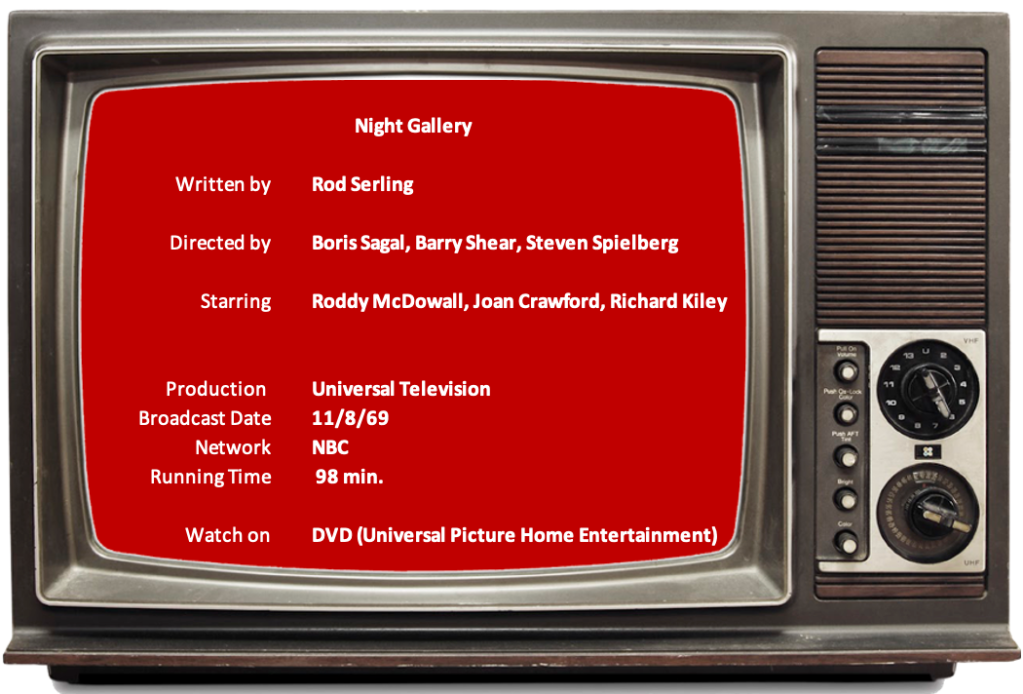
Good anthologies save the best of their short stories for last. Of course, opinions differ, but for me, Night Gallery (1969) has the order wrong. That’s not to say the overall package is bad in any way. It’s just that Rod Serling gives us the scariest, most effective segment at the beginning. I’m going to present my thoughts on the Night Gallery trilogy of tales in my own sequence.
#1: Eyes
Objet d’art number
two: a portrait. Its subject, Miss Claudia Menlo, a blind queen who reigns in a carpeted penthouse on Fifth Avenue. An imperious, predatory dowager who will soon find a darkness blacker than blindness. This is her story.
Eyes is probably everyone’s favorite segment, if it’s not because it’s Steven Spielberg’s first professional directorial effort, it’s because Joan Crawford gives such a chilling performance. The man painting her portrait says there’s one thing he couldn’t capture: her cruelty. Blind since birth, she’d pay any price and blackmail any lawyer or doctor so that she can see, even if it’s only for a few hours.
I’ve watched and watched and watched Eyes and there’s something about it that just doesn’t quite click for me. The hook is terrific: the moment she can see, there’s a blackout and everything turns dark. It’s fine that we see the same darkness, but the reveal of the reason feels clunky. It’s never hit me in the gut like my mind tells me it should. I’ve often wondered if we should know about the blackout earlier.
#2: Escape Route
And now, the
finalpainting. The last of our exhibit has to do with one Josef Strobe, a Nazi war criminal hiding in South America. A monster who wanted to be a fisherman. This is his story.
While Eyes never quite satisfies me, I appreciate Escape Route more each time I watch it. This probably comes from age as I’ve learned more over the years about humanity and the atrocities we continue to commit. Sure, Nazis are bad and we know they did bad things, but their punishment sometimes seems generic. In this case, I forget how the character of Bleum (Sam Jaffe) adds depth to the story.
Years after the fact, he recognizes the man who tortured him in Auschwitz (Richard Kiley) while visiting a museum in South America. Kiley’s character is ambiguous to me. He desperately wants to escape reality by entering a serene painting, but I don’t know that it’s because he feels any remorse for his past actions. In any case, he gets what he deserves in a more effective twist than Joan Crawford does in Eyes.
#3: The Cemetery
Our
initialoffering: a small gothic item of blacks and grays. A piece of the past known as the family crypt. This one we call simply “The Cemetery.” Offered to you now, six feet of earth and all that it contains.
The Cemetery is a good, old-fashioned, EC Comics kind of horror story. Jeremy Evans (Roddy McDowall) ingratiates himself into the life of his dying uncle, then moves the timeline forward a little faster by killing him so he can inherit his fortune. Everything about Jeremy is sleazy and we know from the first time we see him that he’s going to meet his comeuppance.
It arrives when a painting of the cemetery on the estate gradually shows William Hendricks (George Macready) rising from his grave and moving toward the front door. Then there’s a knock… It’s perhaps a little familiar; however, there’s a double-whammy at the end and there’s someone who might deserve their end more than Jeremy. This causes you to reflect on what you’ve seen and reevaluate events.
Over a year later, Serling and Night Gallery returned as a weekly television series. I’ve always thought of The Twilight Zone as the science-fiction anthology, and Night Gallery as the horror anthology, although they each sometimes mix elements of both genres. The Night Gallery episodes are a little more hit and miss than the three stories in the pilot film, which is mostly solid, but a little soft in some spots.


Leave a comment